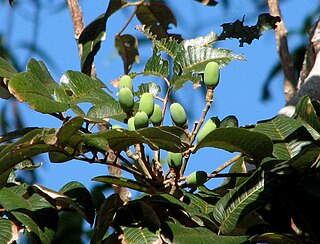
Alectryon is a genus of about 30 species of trees and shrubs from the family Sapindaceae. They grow naturally across Australasia, Papuasia, Melanesia, western Polynesia, east Malesia and Southeast Asia, including across mainland Australia, especially diverse in eastern Queensland and New South Wales, the Torres Strait Islands, New Guinea, the Solomon Islands, New Caledonia, New Zealand, Vanuatu, Fiji, Samoa, Hawaii, Indonesia and the Philippines. They grow in a wide variety of natural habitats, from rainforests, gallery forests and coastal forests to arid savannas and heaths.

Canarium australianum is a species of trees, native to Australia and Papua New Guinea, of the plant family Burseraceae. Common names include mango bark, scrub turpentine, carrot wood, parsnip wood, Melville Island white beech and brown cudgerie.

Lepiderema is a genus of nine species of trees from the family Sapindaceae. As of November 2013 botanists know of seven species growing naturally in Australia and two species in New Guinea. Published botanical science provides a limited knowledge of the full range of diversity in Australia and especially in New Guinea. In New Guinea the two known species have descriptions based each on only a single type specimen collection. Therefore, collection of more specimens and more species is most likely in New Guinea. In Australia they grow in rainforests of the northern half of the east coast side of the Great Dividing Range, from northeastern New South Wales through to northeastern Queensland.

Trochocarpa is a genus of shrubs or small trees, of the plant family Ericaceae. They occur naturally through coastal and montane eastern Australian rainforests and mountain shrublands and in New Guinea, Borneo and Sulawesi (Malesia).

Hedraianthera is a genus of a sole recognised species of shrubs or small trees endemic to Australia from the family Celastraceae.

Gymnostoma australianum, commonly known as the Daintree pine or Daintree oak, is a species of small tree which is endemic to a restricted area of the Daintree tropical rainforests region, within the Wet Tropics of north-eastern Queensland, Australia. It is a member of the plant family Casuarinaceae, often named she-oaks, members of which are characterised by drooping equisetoid evergreen foliage, and separate male and female flowers (unisexual). Superficially they look like well known scale–leaved gymnosperm trees species, such as Cupressus in the northern hemisphere and Callitris in the southern hemisphere.
Hollandaea is a small genus of plants in the family Proteaceae containing four species of Australian rainforest trees. All four species are endemic to restricted areas of the Wet Tropics of northeast Queensland.

Lasjia is a genus of five species of trees of the family Proteaceae. Three species grow naturally in northeastern Queensland, Australia and two species in Sulawesi, Indonesia. Descriptively they are the tropical or northern macadamia trees group. Lasjia species characteristically branched compound inflorescences differentiate them from the Macadamia species, of Australia, which have characteristically unbranched compound inflorescences and only grow naturally about 1,000 km (620 mi) further to the south, in southern and central eastern Queensland and in northeastern New South Wales.

Mischarytera is a genus of rainforest trees, constituting part of the plant family Sapindaceae. Four species are known to science as of December 2013, found growing naturally in eastern Queensland, Australia, and in New Guinea. Formerly until 1995, they had names within the genus Arytera, subgenus Mischarytera.

Sarcotoechia is a genus of tropical rainforest trees, constituting part of the plant family Sapindaceae.
Rhysotoechia is a genus of tropical rainforest trees, constituting part of the plant family Sapindaceae.
Synima is a genus of tropical rainforest trees, constituting part of the plant family Sapindaceae.

Deplanchea is a genus of about eight species of tropical rainforest trees, constituting part of the plant family Bignoniaceae.
Canarium acutifolium is a forest tree species, of the plant family Burseraceae, growing naturally in New Guinea, the Moluccas, Sulawesi, New Britain, New Ireland, Bougainville and in lowland north-eastern Queensland, Australia.
Canarium vitiense is a rainforest tree species, of the plant family Burseraceae, growing naturally in Fiji, the Solomon Islands, Samoa, Tonga, New Guinea, Bismarck Archipelago, Admiralty Islands, Louisiade Archipelago, Torres Strait Islands and in lowland north-eastern Queensland, Australia.
Lepidopetalum is a genus of six species of trees known to science, constituting part of the plant family Sapindaceae.
Cnesmocarpon is a genus of 4 species of rainforest trees known to science, constituting part of the plant family Sapindaceae.
Dictyoneura is a genus of two-to-three species of rainforest trees known to science, constituting part of the plant family Sapindaceae.

Dysoxylum parasiticum, known as yellow mahogany, is a species of rainforest trees in the family Meliaceae. The specific epithet parasiticum is from the Latin meaning "parasitic", referring to the idea that the flowers are parasitic on another tree species.
Lindsayomyrtus is a monotypic genus in the family Myrtaceae, containling the single species Lindsayomyrtus racemoides, commonly known as Daintree penda. These large trees grow naturally in the rainforests of the Wet Tropics of Queensland in Australia, the Moluccas, New Guinea and New Britain.











